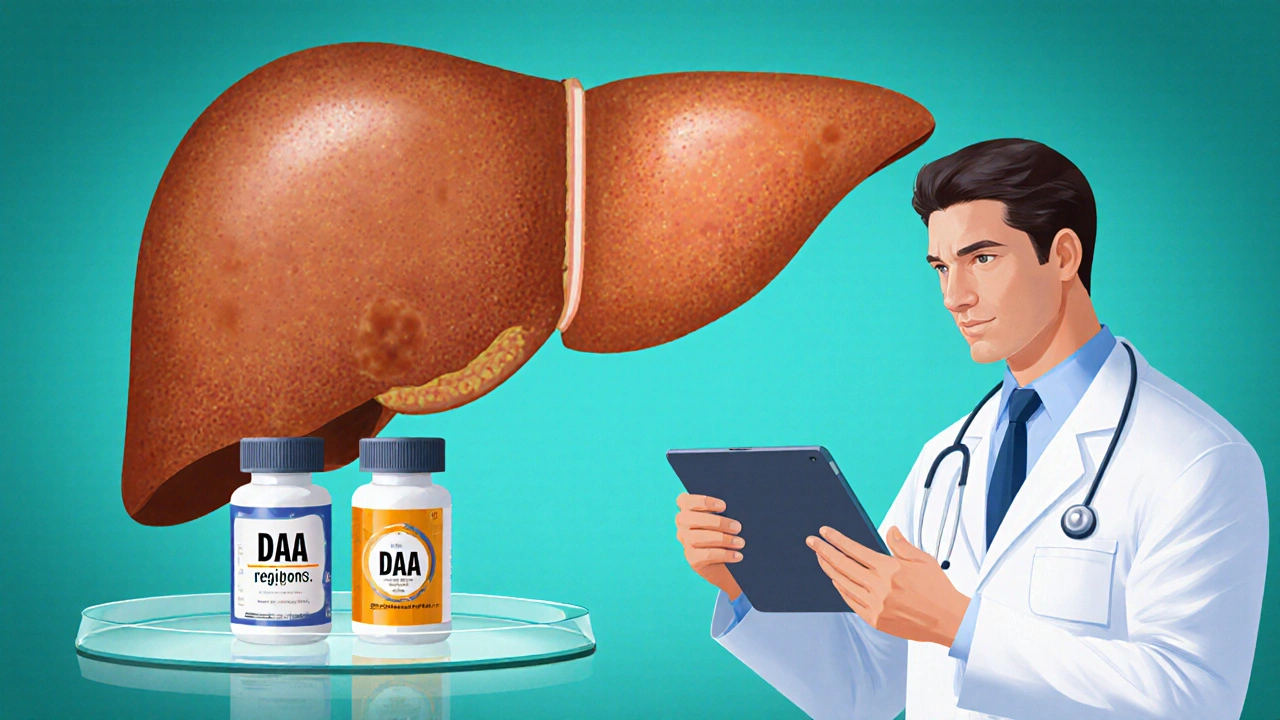Hepatitis C Drug Interaction Checker
Check Your Medication Interactions
This tool checks for potential interactions between your current medications and direct-acting antivirals (DAAs) used to treat hepatitis C in seniors. Important: This is not a substitute for professional medical advice. Always consult your healthcare provider.
Interaction Results
Detailed Information
When people think about hepatitis C, they often picture younger patients with a history of injection drug use. In reality, a growing number of cases are being diagnosed in people over 65, many of whom have lived with the virus for decades without knowing it. This article unpacks what older adults need to know - from risk factors and screening to modern treatment options that work even with age‑related health challenges.
Key Takeaways
- Hepatitis C infection can remain silent for years; routine screening is the most reliable way to catch it early in seniors.
- Direct‑acting antiviral (DAA) regimens achieve cure rates above 95% in older patients, with fewer side effects than older interferon‑based therapies.
- Age‑related liver changes and common comorbidities (diabetes, heart disease) influence treatment planning but rarely preclude cure.
- Regular liver health monitoring after cure is still important because advanced fibrosis can persist.
- Understanding insurance coverage, especially Medicare, helps avoid costly delays.
Hepatitis C is a viral infection caused by the hepatitis C virus (HCV) that primarily attacks the liver, leading to inflammation, fibrosis, and potentially cirrhosis or liver cancer. It spreads through blood-to-blood contact and can remain asymptomatic for decades, making targeted screening essential for older adults.
Why Seniors Are at Higher Risk
Older adults face three main reasons that increase their risk of undiagnosed hepatitis C:
- Historical exposure: Many people born between 1945 and 1965 (the "baby‑boom" cohort) experienced medical procedures before rigorous blood‑screening standards were implemented.
- Long‑term silent infection: HCV can linger without symptoms, and liver damage accumulates slowly, often surfacing only when liver function declines.
- Competing health issues: Chronic conditions like diabetes or cardiovascular disease can mask liver‑related symptoms, delaying testing.
Understanding these factors helps clinicians prioritize screening in the senior population.
Screening Guidelines for Older Adults
Current recommendations from the Australian Therapeutic Guidelines and the US CDC suggest a one‑time HCV antibody test for anyone born between 1945 and 1965, regardless of perceived risk. For seniors, the screening pathway looks like this:
- Step 1 - Antibody test: A simple blood draw checks for HCV antibodies.
- Step 2 - Confirmatory RNA test: If antibodies are present, a nucleic acid test (NAT) measures active viral RNA.
- Step 3 - Liver assessment: Fibrosis staging using transient elastography (FibroScan) or blood‑based scores (APRI, FIB‑4) determines disease severity.
Because older adults often have reduced immune responsiveness, a negative antibody test does not completely rule out infection if recent exposure is suspected; a direct RNA test may be warranted.

Treatment Landscape: Direct‑Acting Antivirals (DAAs)
The shift from interferon‑based regimens to DAAs has transformed hepatitis C care for seniors. DAAs target specific stages of the viral life‑cycle, leading to rapid viral clearance and high cure rates (sustained virologic response, SVR). Below is a comparison of the most common DAA regimens used in patients aged 65 and older.
| Regimen | Genotype Coverage | Typical Duration | SVR Rate (≥65y) | Key Considerations |
|---|---|---|---|---|
| sofosbuvir/velpatasvir | All genotypes (1‑6) | 12 weeks (8 weeks if no cirrhosis & low viral load) | 96‑98% | Renal dose adjustment not needed; watch for drug‑drug interactions with statins. |
| glecaprevir/pibrentasvir | All genotypes | 8 weeks (12 weeks if cirrhosis) | 95‑97% | Limited data for severe renal impairment; avoid concomitant CYP3A4 inducers. |
| sofosbuvir/ledipasvir | Genotype 1, 4, 5, 6 | 12 weeks (8 weeks if no cirrhosis & low viral load) | 94‑96% | Well‑tolerated; monitor for mild anemia in patients on ribavirin. |
Across all regimens, side effects are mild - fatigue, headache, or occasional nausea - a stark contrast to the flu‑like symptoms of older interferon therapies.
Managing Comorbidities and Drug Interactions
Older patients often take multiple medications. The primary concern with DAAs is drug‑drug interaction (DDI). A practical checklist helps clinicians and patients navigate this:
- Review all current prescriptions, over‑the‑counter meds, and supplements.
- Use the Hepatitis C Interaction Checker (available from the Australian Medicines Handbook) to flag contraindications.
- Adjust doses of anticoagulants (e.g., warfarin) or statins if required - some DAAs increase their blood levels.
- For patients with chronic kidney disease (eGFR <30mL/min), prefer regimens with minimal renal clearance, such as glecaprevir/pibrentasvir (with caution).
- Coordinate with cardiologists for patients on amiodarone; certain DAAs can cause bradycardia when combined.
Open communication between primary care, hepatology, and pharmacy teams minimizes adverse events and keeps treatment on track.
Post‑Treatment Follow‑Up and Long‑Term Health
Achieving an SVR is considered a cure, but older adults may still need ongoing monitoring because:
- Advanced fibrosis or cirrhosis does not reverse completely; regular ultrasound screens for hepatocellular carcinoma (HCC) remain recommended every six months.
- Liver function tests (ALT, AST) should be checked annually to catch any new insult.
- Vaccination against hepatitis A and B is advised to prevent additional liver injury.
Maintaining a healthy lifestyle - balanced diet, regular low‑impact exercise, and limiting alcohol - further protects liver health after cure.

Insurance, Cost, and Access in Australia
For seniors, the biggest hurdle often isn’t medical but financial. Here’s a quick rundown of how to secure coverage:
- Medicare Benefits Schedule (MBS): Most DAAs are listed, allowing bulk‑billing or reduced copay for eligible patients.
- Pharmaceutical Benefits Scheme (PBS): Grants subsidized access to first‑line DAAs for patients meeting clinical criteria (e.g., fibrosis stage ≥F2 or extra‑hepatic manifestations).
- Private Health Insurance: Can cover additional costs such as specialist consultations, liver imaging, and travel subsidies.
- Community Health Grants: Many state health departments run targeted hepatitis C elimination programs offering free testing and treatment for seniors.
Patients should ask their GP to initiate a referral to a hepatitis C specialist who can handle the paperwork and ensure timely treatment start.
Practical Tips for Older Adults and Caregivers
- Schedule screenings during routine health checks - bundle HCV testing with cholesterol or diabetes reviews.
- Keep a medication list up to date, noting start and stop dates.
- Set reminders for follow‑up labs - use phone alarms or pharmacy refill alerts.
- Engage a trusted caregiver for appointment transportation and medication management.
- Stay informed - reputable sources include the Australian Hepatitis Council and the World Health Organization.
Frequently Asked Questions
Can I still be cured of hepatitis C after age 70?
Yes. Clinical trials show cure rates above 95% in patients aged 70‑79 when treated with modern DAAs, provided liver function is stable and drug interactions are managed.
Do I need a liver biopsy before starting treatment?
No. Non‑invasive tools like FibroScan or serum‑based scores (APRI, FIB‑4) reliably stage fibrosis in most older adults, eliminating the need for an invasive biopsy.
Will my existing heart medication interfere with hepatitis C pills?
Some DAAs can raise levels of certain statins or anticoagulants. A pharmacist can run a DDI check and suggest dosage adjustments or alternative heart meds if needed.
How often should I get liver ultrasounds after cure?
If you had cirrhosis before treatment, semi‑annual ultrasounds are recommended to screen for hepatocellular carcinoma. For lower fibrosis stages, annual imaging is usually sufficient.
Is hepatitis C testing covered by Medicare?
Yes. The MBS includes a full rebate for the antibody test and the confirmatory RNA test when ordered by a GP or specialist for eligible age groups.

NANDKUMAR Kamble
I keep hearing that seniors are being used as guinea pigs for some pharma plot. It feels like they're pushing a hidden agenda with these new drugs.
namrata srivastava
The epistemological framework underpinning the referenced DAA pharmacodynamics necessitates a rigorous ontological appraisal, particularly vis-à-vis geriatric metabolic variance.
Priyanka arya
Wow 😱! Who would've thought the silent virus could be lurking in our grandparents 🧓🏽? This whole thing is like a hidden treasure hunt 🕵️♀️!
Loren Kleinman
When we contemplate the arc of medical progress, we are reminded that each breakthrough rests upon the shoulders of countless unnoticed lives. The elderly, having borne the silent weight of hepatitis C for decades, embody that hidden narrative. Their bodies have adapted in ways we are only beginning to understand, and that adaptation informs how we dose modern therapies. It is not merely a matter of pharmacokinetics; it is an ethical dialogue about dignity. We must ask whether the promise of a cure respects the lived experience of age. The answer lies in personalized care plans that honor both science and humanity. Moreover, the interplay between comorbidities and antiviral regimens demands meticulous attention. A statin might become a source of toxicity if not monitored, just as a blood thinner may need adjustment. These nuances are why interdisciplinary teams are essential. They translate complex data into actionable guidance for seniors. In a world obsessed with speed, we must not rush the conversation. Patience allows us to gather real‑world outcomes that validate clinical trial results. The high sustained virologic response rates are encouraging, but they are numbers until a patient feels better. Ultimately, the true measure of success is a life lived fully, not just a virus eradicated.
Sabrina Goethals
Seriously, another drug checker? 🙄
Sudha Srinivasan
We should demand transparency before handing seniors any pills.
Jenny Spurllock
Screening older adults makes sense because the disease can stay hidden for decades, and early detection saves lives.
Bart Cheever
This is just marketing fluff, nothing new.
Maude Rosièere Laqueille
Actually, the DAA regimens have shown SVR rates over 95% even in patients over 70, with side effects comparable to a mild cold.
The key is assessing liver fibrosis before starting therapy.
Also, reviewing concomitant meds prevents dangerous interactions.
Medicare now covers most of the cost, so financial barriers are lower.
Amanda Joseph
Oh great, another miracle cure, because we needed more buzzwords.